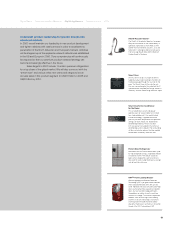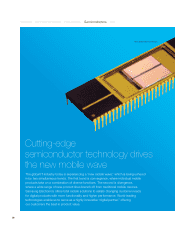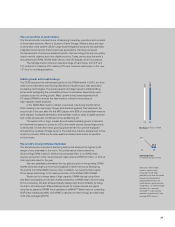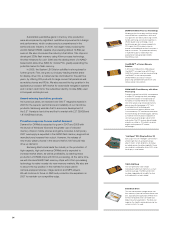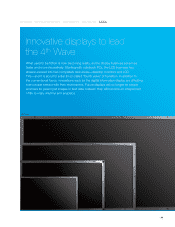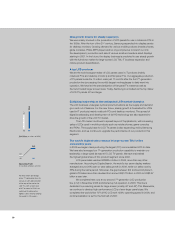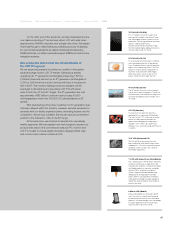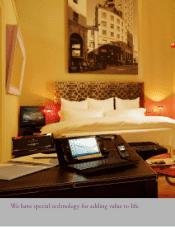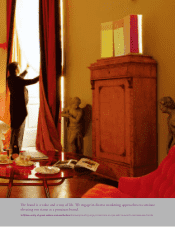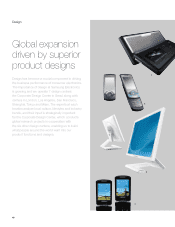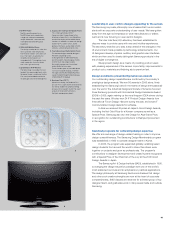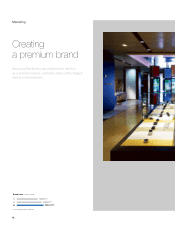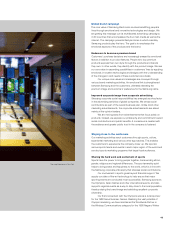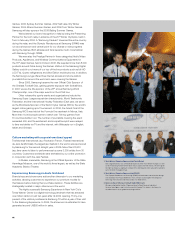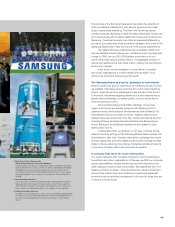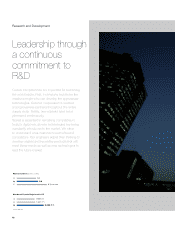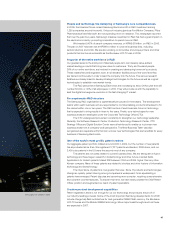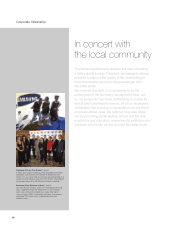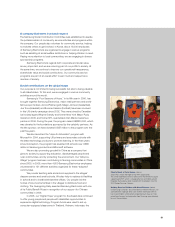Samsung 2006 Annual Report Download - page 51
Download and view the complete annual report
Please find page 51 of the 2006 Samsung annual report below. You can navigate through the pages in the report by either clicking on the pages listed below, or by using the keyword search tool below to find specific information within the annual report.
41
Leadership in user-centric designs appealing to the senses
The Samsung corporate philosophy now stresses that true innovation
starts with an accurate understanding of user needs. We have gotten
away from the age-old emphasis on what manufacturers or sellers
want and is now focusing on user-centric designs.
The User Interface (UI) Laboratory has been established to
discover ways to provide users with new and intuitive experiences.
The laboratory enables us to stay a step ahead of the changes in the
UI environment made possible by technology advancements. Our
UI designers develop physical, auditory and graphic user interfaces,
which are then used to clearly distinguish Samsung products in the
era of digital convergence.
We approach design as a means of providing product users
with pleasing experiences of the senses. Importantly, improvements to
product color, materials and finishing add a premium feel.
Design excellence presented by numerous awards
Our outstanding design capabilities are confirmed by the industry’s
prestigious design awards. We won 80 awards in 2006 alone, firmly
establishing the Samsung brand in the hearts of design enthusiasts all
over the world. The Industrial Designers Society of America honored
three Samsung products with its Industrial Design Excellence Award
(IDEA) in 2006, again making us the most frequent IDEA winner during
the past five years. We also won 24 iF Product Design Awards from
International Forum Design Hanover during the year, and seven iF
Communication Design Awards for software.
In Asia we received 24 prizes at Japan’s Good Design Awards,
including the first Gold Prize for a Korean company as well as a
Special Prize. Samsung also won the Design for Asia Grand Prize,
in recognition for outstanding contributions to lifestyle improvement
in the region.
Standout programs for cultivating design expertise
We offer a broad range of design-related training in order to improve
design competitiveness. The Samsung Design Membership program
was established in 1993 to cultivate designer talent in Korea.
In 2006, the program was expanded globally, enabling select
design students from around the world to share their ideas, work
together on projects and grow as professionals. The program’s
contributions to designer development and creativity were recognized
with a Special Prize of the Chairman of the Jury at the 2006 Good
Design Awards in Japan.
The Samsung Art & Design Institute (SADI), established in 1995,
is changing the design education paradigm with one of the world’s
most advanced curricula and an emphasis on practical applications.
The design philosophy at Samsung Electronics stresses that design
and other such creative strengths are now at the heart of corporate
competitiveness. SADI classes are reserved for a limited group of top
designer talent, and graduates work in many areas inside and outside
Samsung.
6
5
1. K5 MP3 Player
The K5 is easy for anyone to use.
The MP3 player and a speaker form
a single unit, while we have created a
unique “slide and tilt” structure to add
a new dimension to the MP3 player
experience.
2. SGH-U600 Mobile Phone
The design concept for this ultra-slim,
semi-automatic slider emphasizes
the “minimal modern” with sleek soft
lines. The motif is inspired by the
smoothly connected joints of
a bamboo stalk. Our engineers have
used magnesium to craft a phone
that is thin, light and sturdy.
3. SynchMaster 971P Monitor
The triple-hinge stand allows the user
to adjust the screen angle freely, while
the overall shape is simple and intuitive.
The stand can be folded to minimize
the package size and facilitate logistics.
4. Graphic User Interface for Mobile Phone
This screen garnered a 2006 iF
Communication Design Award in the
Interface category for its user-friendliness
and intuitive display of the mobile phone
functions. In addition, we have won design
awards for PC screen savers, home
gateway interfaces, audio-video network
solutions, and exhibit promotion sites.
5. Touch Messenger Braille Mobile Phone
This concept design created by designers
from Samsung Design China
(in Shanghai) won an IDEA Gold Award,
one of the world’s most prestigious honors,
in 2006. Touch Messenger enables
the visually impaired users to send and
receive Braille text messages.
The 3×4 button layout on the mobile phone
is used as two Braille keypads, while text
messages and the phone operating status
can be checked through the Braille display
screen beneath the keypad.
6. Bordeaux Plus LCD TV
More than a display, the Bordeaux Plus
32˝ LCD TV is a work of art that will enhance
any interior. Subtle lines project a feeling
of clear and transparent sound. The use of
lacquer on the exterior harmonizes
the black and opaque materials.


